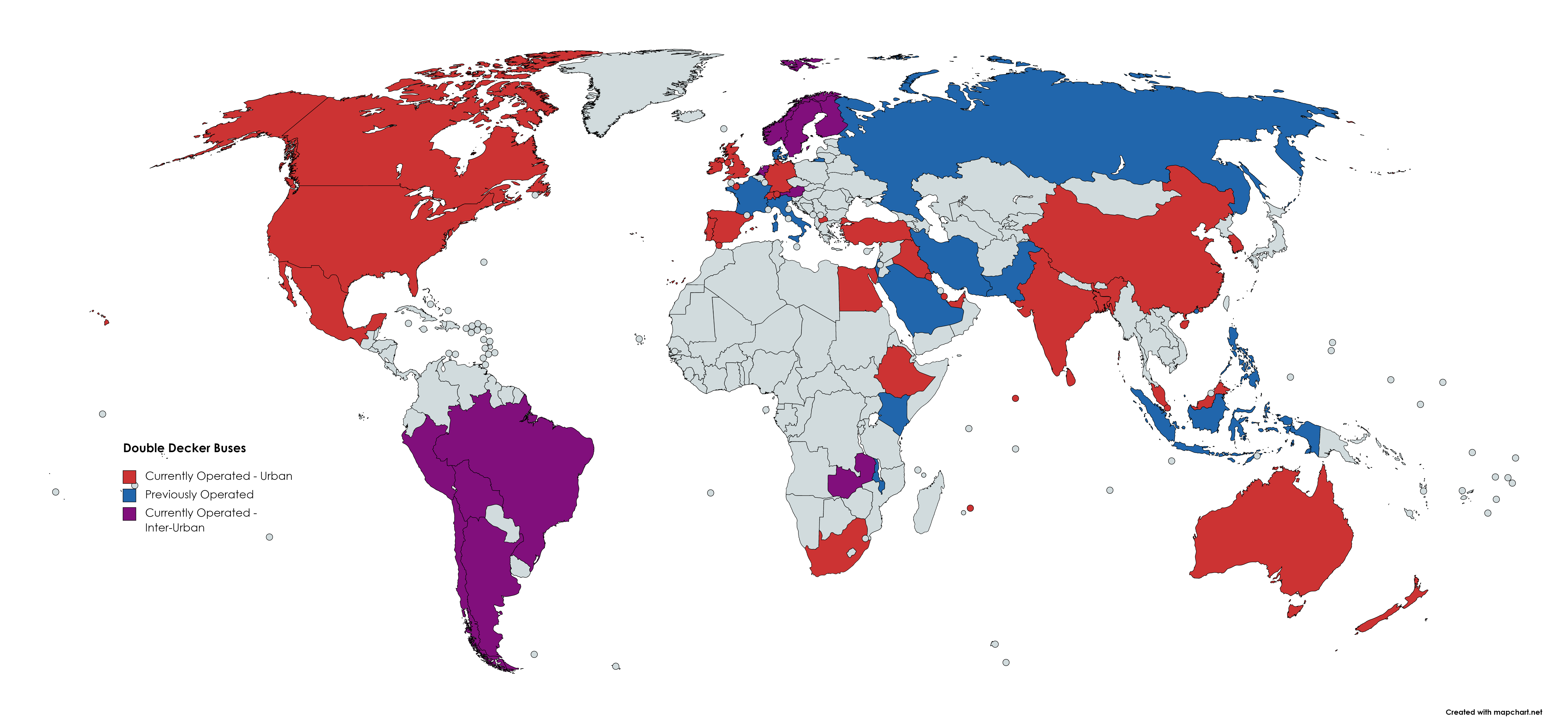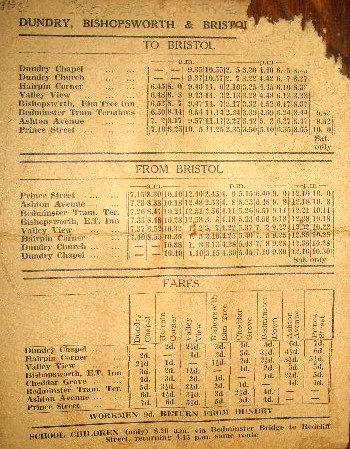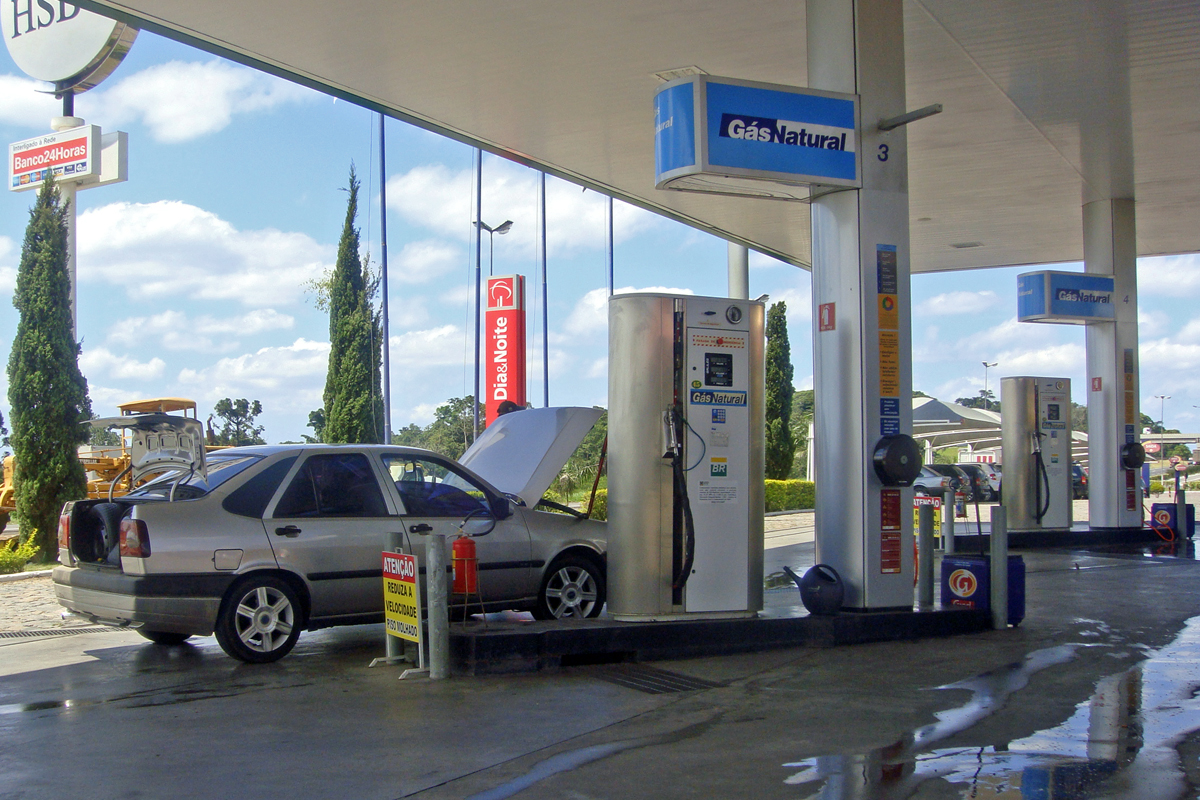|
Bus
A bus (contracted from omnibus, with variants multibus, motorbus, autobus, etc.) is a motor vehicle that carries significantly more passengers than an average car or van, but fewer than the average rail transport. It is most commonly used in public transport, but is also in use for charter purposes, or through private ownership. Although the average bus carries between 30 and 100 passengers, some buses have a capacity of up to 300 passengers. The most common type is the single-deck rigid bus, with double-decker and articulated buses carrying larger loads, and midibuses and minibuses carrying smaller loads. Coaches are used for longer-distance services. Many types of buses, such as city transit buses and inter-city coaches, charge a fare. Other types, such as elementary or secondary school buses or shuttle buses within a post-secondary education campus, are free. In many jurisdictions, bus drivers require a special large vehicle licence above and beyond a regular drivi ... [...More Info...] [...Related Items...] OR: [Wikipedia] [Google] [Baidu] |
Electric Bus
An electric bus is a bus that is propelled using electric motors, as opposed to a conventional internal combustion engine. Electric buses can store the needed electrical energy on board, or be fed mains electricity continuously from an external source such as overhead lines. The majority of buses using on-board energy storage are battery electric buses (which is what this article mostly deals with), where the electric motor obtains energy from an electric vehicle battery, onboard battery pack, although examples of other storage modes do exist, such as the gyrobus that uses flywheel energy storage. When electricity is not stored on board, it is supplied by contact with outside power supplies, for example, via a current collector (like the trolley pole, overhead conduction poles in trolleybuses), or with a ground-level power supply, or through Inductive charging#Dynamic charging, inductive charging. As of 2017, 99% of all battery electric buses in the world have been deployed in M ... [...More Info...] [...Related Items...] OR: [Wikipedia] [Google] [Baidu] |
Double-decker Bus
A double-decker bus is a bus that has two storeys or decks. Double-deckers are used primarily for commuter transport, but open-top models are used as sightseeing buses for tourists, and there are coaches too for long-distance travel. They appear in many places around the world but are presently most commonly used as mass transport in cities of Britain, and in Ireland, China, Hong Kong, Berlin and Singapore. The earliest double-decker horse-drawn omnibus appeared in Paris in 1853 and such vehicles were motorised in the 1900s. Double-decker buses were popularised in Great Britain at the start of the 20th century and today the best-known example is the red London bus, namely the AEC Routemaster. Double-deckers in urban transport were also in common use in other places, such as major cities of India, but were mostly diminished or phased out by the end of the 20th century. However they remain common in Britain as well as Ireland and Hong Kong, while in Singapore and Dhaka they ... [...More Info...] [...Related Items...] OR: [Wikipedia] [Google] [Baidu] |
School Bus
A school bus is any type of bus owned, leased, contracted to, or operated by a school or school district. It is regularly used to Student transport, transport students to and from school or school-related activities, but not including a charter bus or transit bus. Various configurations of School bus by country, school buses are used worldwide; the most iconic examples are the yellow school buses of the United States which are also found in other parts of the world. In North America, school buses are purpose-built vehicles distinguished from other types of buses by design characteristics mandated by federal and state/provincial regulations. In addition to their distinct paint color (National School Bus Glossy Yellow), school buses are fitted with exterior warning lights (to give them traffic priority) and multiple safety devices. [...More Info...] [...Related Items...] OR: [Wikipedia] [Google] [Baidu] |
Trolleybus
A trolleybus (also known as trolley bus, trolley coach, trackless trolley, trackless tramin the 1910s and 1920sJoyce, J.; King, J. S.; and Newman, A. G. (1986). ''British Trolleybus Systems'', pp. 9, 12. London: Ian Allan Publishing. .or trolleyDunbar, Charles S. (1967). ''Buses, Trolleys & Trams''. Paul Hamlyn Ltd. (UK). Republished 2004 with or 9780753709702.) is an electric bus that draws power from dual overhead wires (generally suspended from roadside posts) using spring-loaded or pneumatically raised trolley poles. Overhead line#Parallel overhead lines, Two wires, and two trolley poles, are required to complete the electrical circuit. This differs from a tram or streetcar, which normally uses the track as the return path, needing only one wire and one pole (or pantograph (transport), pantograph). They are also distinct from other kinds of Battery electric bus, electric buses, which usually rely on Automotive battery, batteries. Power is most commonly supplied as 600-volt ... [...More Info...] [...Related Items...] OR: [Wikipedia] [Google] [Baidu] |
Fuel Cell Bus
A fuel cell bus is a bus that uses a hydrogen fuel cell as its power source for Electric motor, electrically driven wheels, sometimes augmented in a Hybrid power, hybrid fashion with batteries or a supercapacitor. The only emission from the bus is water. Several cities around the world have trialled and tested fuel cell buses, with over 5,600 buses in use worldwide, the majority of which are in China. Background Owing to the greenhouse gas emissions and particulate pollution produced by diesel buses, transport operators have been moving towards greener and cleaner buses (such as hybrid electric buses and battery electric buses) since the early 2000s. However, battery electric buses lack range compared to diesel buses, take time to charge and have reduced energy storage in cold weather. Transport operators have therefore evaluated alternatives such as hydrogen fuel cell buses. fuel cell, Hydrogen fuel cells generate electricity by reacting hydrogen and oxygen in the presence of a c ... [...More Info...] [...Related Items...] OR: [Wikipedia] [Google] [Baidu] |
Articulated Bus
An articulated bus, also referred to as a slinky bus, bendy bus, tandem bus, vestibule bus, stretch bus, or an accordion bus, is an articulated vehicle, typically a motor bus or trolleybus, used in public transportation. It is usually a single-decker, and comprises two or more rigid sections linked by a pivoting joint (articulation) enclosed by protective bellows inside and outside and a cover plate on the floor. This allows a longer legal length than rigid-bodied buses, and hence a higher passenger capacity (94–120), while still allowing the bus to maneuver adequately. Due to their high passenger capacity, articulated buses are often used as part of bus rapid transit schemes, and can include mechanical guidance system and electric bus or trolleybus. Articulated buses are typically long, in contrast to standard rigid buses at long. The common arrangement of an articulated bus is to have a forward section with two axles leading a rear section with a single axle, w ... [...More Info...] [...Related Items...] OR: [Wikipedia] [Google] [Baidu] |
Scheduled Coach Transport
An intercity bus service (North American English) or intercity coach service (British English and Commonwealth English), also called a long-distance, express, over-the-road, commercial, long-haul, or highway bus or coach service, is a public transport service using coaches to carry passengers significant distances between different cities, towns, or other populated areas. Unlike a transit bus service, which has frequent stops throughout a city or town, an intercity bus service generally has a single stop at one location in or near a city – usually at a transit interchange – and travels long distances without stopping at all. Intercity bus services may be operated by government agencies or private industry, for profit and not for profit. Intercity coach travel can serve areas or countries with no train services, or may be set up to compete with trains by providing a more flexible or cheaper alternative. Intercity bus services are of prime importance in lightly populated rur ... [...More Info...] [...Related Items...] OR: [Wikipedia] [Google] [Baidu] |
Public Transport Bus Service
Public transport bus services are generally based on regular operation of transit buses along a route calling at agreed bus stops according to a published public transport timetable. History of buses Origins While there are indications of experiments with public transport in Paris as early as 1662, there is evidence of a scheduled "bus route" from Market Street (Manchester), Market Street in Manchester to Pendleton, Greater Manchester, Pendleton in City of Salford, Salford UK, started by John Greenwood d.1851, John Greenwood in 1824. Another claim for the first public transport system for general use originated in Nantes, France, in 1826. , a retired army officer who had built public baths using the surplus heat from his flour mill on the city's edge, set up a short route between the center of town and his baths. The service started on the Place du Commerce, outside the hat shop of a M. Omnès, who displayed the motto ''Omnès Omnibus'' (Latin for "everything for everybod ... [...More Info...] [...Related Items...] OR: [Wikipedia] [Google] [Baidu] |
Internal Combustion Engine
An internal combustion engine (ICE or IC engine) is a heat engine in which the combustion of a fuel occurs with an oxidizer (usually air) in a combustion chamber that is an integral part of the working fluid flow circuit. In an internal combustion engine, the expansion of the high-temperature and high-pressure gases produced by combustion applies direct force to some component of the engine. The force is typically applied to pistons (reciprocating engine, piston engine), turbine blades (gas turbine), a Wankel engine, rotor (Wankel engine), or a propulsive nozzle, nozzle (jet engine). This force moves the component over a distance. This process transforms chemical energy into kinetic energy which is used to propel, move or power whatever the engine is attached to. The first commercially successful internal combustion engines were invented in the mid-19th century. The first modern internal combustion engine, the Otto engine, was designed in 1876 by the German engineer Nicolaus ... [...More Info...] [...Related Items...] OR: [Wikipedia] [Google] [Baidu] |
Hybrid Electric Bus
A hybrid electric bus is a bus that combines a conventional internal combustion engine propulsion system with an electric propulsion system. These types of buses normally use a diesel–electric powertrain and are also known as hybrid diesel–electric buses. The introduction of hybrid electric vehicles and other green vehicles for purposes of public transport forms a part of sustainable transport schemes. Powertrain Types of hybrid vehicle drivetrain A hybrid electric bus may have either a parallel powertrain (e.g., Volvo B5LH) or a series powertrain (e.g., some versions of the Alexander Dennis Enviro400 MMC). Since 2003, Allison Transmission has produced dual-mode hybrid drive units which take the place of a conventional transmission, mostly for transit buses in North America; as the name implies, it is able to switch between series and parallel modes. Plug-in hybrid A plug-in hybrid school bus effort began in 2003 in Raleigh, NC, when Advanced Energy began ... [...More Info...] [...Related Items...] OR: [Wikipedia] [Google] [Baidu] |
School Transport
Student transport is the transporting of children and teenagers to and from schools and school events. School transport can be undertaken by school students themselves (on foot, bicycle or perhaps Equestrianism, horseback; or for older students, by car), they may be accompanied by family members or caregivers, or the transport may be organised collectively, using school buses or taxicab, taxis. Transport modes General public transport Using the general-purpose public transport is the most common means of student transport, in some countries. Some countries such as Australia have special routes and timetables exclusively used by students, but still run by public transportation services. Sometimes the parents or the students get reimbursed when they buy public transport tickets. School bus Student transport can use specially designed school buses. Many districts in Canada and the United States use specially built and equipped school buses, painted school bus yellow and equippe ... [...More Info...] [...Related Items...] OR: [Wikipedia] [Google] [Baidu] |
Compressed Natural Gas
Compressed natural gas (CNG) is a fuel gas mainly composed of methane (CH4), compressed to less than 1% of the volume it occupies at standard atmospheric pressure. It is stored and distributed in hard containers at a pressure of , usually in cylindrical or spherical shapes. CNG is used in traditional petrol/internal combustion engine vehicles that have been modified, or in vehicles specifically manufactured for CNG use: either alone (dedicated), with a segregated liquid fuel system to extend range (dual fuel), or in conjunction with another fuel ( bi-fuel). It can be used in place of petrol, diesel fuel, and liquefied petroleum gas (LPG). CNG combustion produces fewer undesirable gases than the aforementioned fuels. In comparison to other fuels, natural gas poses less of a threat in the event of a spill, because it is lighter than air and disperses quickly when released. Biomethane, biogas from anaerobic digestion or landfill, can be used. In response to high fuel prices a ... [...More Info...] [...Related Items...] OR: [Wikipedia] [Google] [Baidu] |











